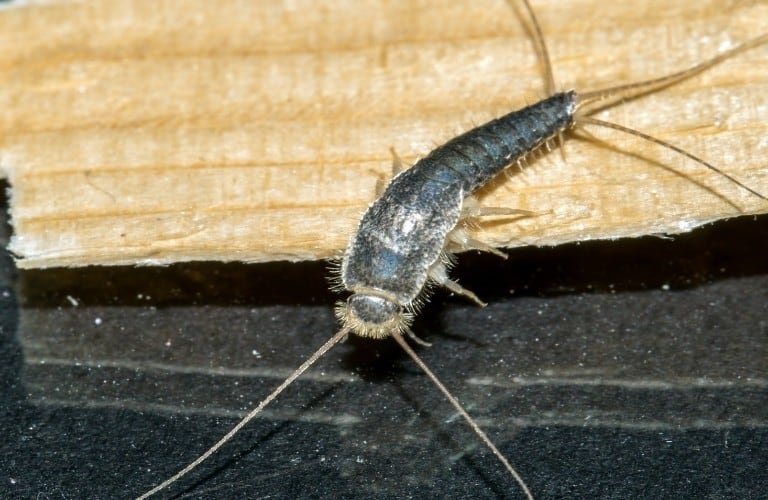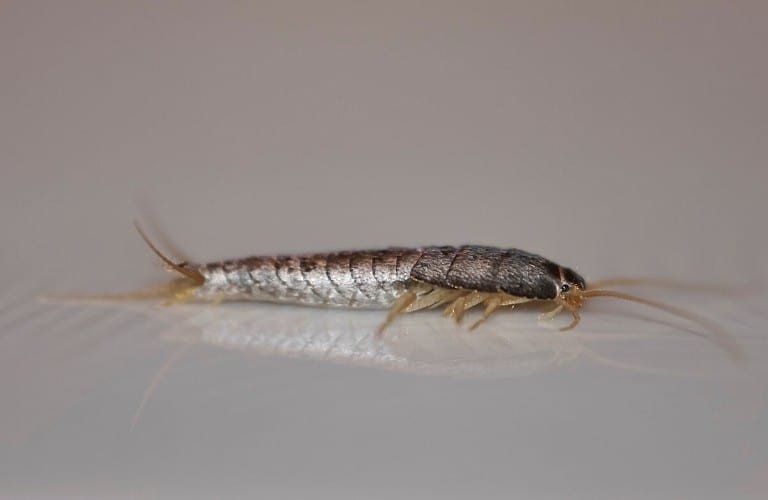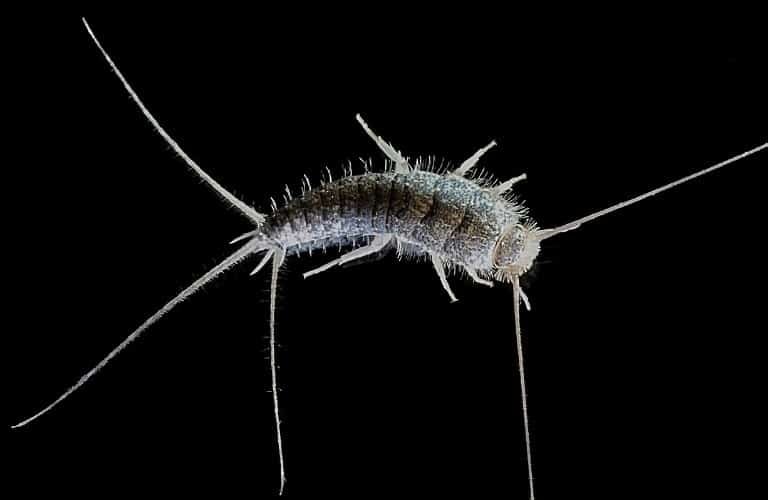Killing silverfish is one of the easiest ways to get rid of them for good, as attempting to repel or trap them can take some time and might not always be effective.
Fortunately, there’s a substance you likely have at home that you can use to fight against them.
Does bleach kill silverfish? Bleach kills silverfish quickly and effectively. It eats away at the proteins in the silverfish and causes them to die. You can spray a mixture of bleach and water in areas where you commonly see them. Use caution as it can be harmful or lethal if used incorrectly.
Let’s take a look at how bleach can be used to effectively kill silverfish as well as how to use it safely.
About Silverfish
Silverfish are nocturnal insects that require high humidity levels. The most common places you’ll find them are kitchens, bathrooms, and boilers.
If your house has an ongoing leak that has been leaking for a long time, you’ll likely find them in the area.
So, this is one instance that spotting a silverfish or two may actually be helpful as they can alert you to a problem you were unaware of.
Silverfish eat starchy foods like pasta and cookies. However, they also like to eat starches that aren’t food, like fabrics, glue, paper, and cardboard.
(You can learn all about their eating habits and preferred food sources in this article.)
Many people often struggle to figure out why these pesky bugs keep venturing indoors.
We cover this topic extensively here, but for now, know that the most common way for silverfish to enter your home is via a cardboard box you brought inside.
It’s possible for them to enter the home from your yard, but this is less likely if you live in a dry area.
Prevention is the best way to keep silverfish out of your home.
Check your pipes and roof frequently to make sure there aren’t any leaks, and if there are, repair them quickly.
If you’re going to move cardboard boxes from an attic or basement to another home or building, it’s best to check for silverfish before you transport the box.
Keep starchy items in airtight containers, whether it’s food in your pantry or books stored in the basement.
For other effective prevention tips, read our article “How Do You Prevent Silverfish?”
If you’d prefer not to use bleach, we have a detailed guide on getting rid of silverfish full of numerous options and tips that you’re sure to find helpful.
Bleach Basics
Bleach is often used for cleaning your home and removing stains from clothing.
It’s important to know a little bit about it to understand how it can be used to kill silverfish.
Ingredients
There are two types of bleach you can buy:
- Chlorine based – This common household bleach is made from sodium hypochlorite and is typically used in laundry or for disinfecting.
- Peroxide based (non-chlorine) – This type of bleach doesn’t contain any chlorine and is usually recognized as “color safe.” It does disinfectant but isn’t as powerful as chlorine bleach.
Uses
Bleach can be used for a variety of purposes, such as:
- Kill pests.
- Disinfect surfaces.
- Remove stains.
- Whiten clothing.
- Remove mold and mildew.
- Clean equipment.
- Treat water.
Chlorine-based bleach is used for most of these, except for removing stains from colored clothing, since it’s more powerful.
Non-chlorine bleach can still be used, but it shouldn’t be diluted as much.
Toxicity
Bleach is a toxic chemical that can be harmful or even lethal if it isn’t used properly.
Bleach should never be used around children or pets and should always be handled with great caution.
Several parts of the body can be affected by bleach if they come into contact with it, including:
- Eyes – The eyes usually become red and teary, and your vision might become blurry.
- Respiratory – Mild or severe irritation can occur. Exposure to chlorine gas, which can be released when hot water and bleach are mixed, can be lethal if it’s inhaled.
- Throat and mouth – Irritation is usually the only symptom.
- Skin – Irritation ranging from mild to severe is likely going to be the only symptom, but try to wash it off quickly to prevent further irritation.
How Bleach Kills Silverfish
If bleach is a stain-removing disinfectant, how does it kill silverfish (and many other pests)?
The way it works is a chemical reaction between the bleach and the bug. The hypochlorite in chlorine-based bleach bonds with bacterial proteins.
This happens when the bleach is used to disinfect a kitchen countertop; bacteria is killed because the bacterial proteins are being destroyed.
So, what does this mean for silverfish? The waxy coating on the outside of their exoskeleton is broken down, and that’s what kills them.
This means that if you spray eggs that have been laid, they’ll die, too.
Drowning them in diluted bleach is also an option if you can manage to catch them.
Not only will the chemical break down their exoskeleton, but they will drown by not being able to escape. It may be gruesome, but it’s an effective option.
The Best Way to Use Bleach for Silverfish
There are a few different approaches you can take when you want to use bleach to fight against silverfish.
Remember that bleach is a dangerous chemical and shouldn’t be used around children or pets. Be mindful of where you spray it.
Spray the Walls
Silverfish often crawl up walls to reach books or dark crevices.
Mix bleach with water in a plastic spray bottle, and spray the solution on the walls every two or three months.
Wearing gloves, use a rag to wipe down the walls after you spray it. You don’t want it to drip down and spread everywhere.
As the silverfish walk across the surface, their feet will pick up the bleach, and it will slowly start to kill them.
This is a slower process of killing them, but it’ll be effective if you remain consistent for several months.
Spray Small Spaces
Silverfish like to make their home in small, dark spaces. Spraying these spaces with a bleach solution like you would use for walls will help get rid of them.
Places you should spray include:
- Corners.
- Floors.
- Under sinks.
- Around boilers.
- Cracks in walls.
- Dark areas.
Once the bleach has dried, it won’t be as effective, but it will still help reduce the number of silverfish.
You can spray these areas frequently if you need long-term control.
Sprays made with essential oils known to deter silverfish can be quite effective as well.
To speed up the process of banishing silverfish from your home, consider using methods involving bleach in conjunction with traps that are proven to be effective on silverfish.
Pour It Down the Drain
Silverfish are attracted to moisture, so you can frequently find them in drains.
Drains are the perfect place for silverfish to lay eggs because it’s dark and there’s plenty of moisture and food available, as well as several crevices for them to lay their eggs.
Mix together a water and bleach solution and pour it down the drain.
It won’t stick around like it will if you were to spray it on surfaces, so you’ll need to do it daily until you don’t see silverfish anymore.
This is an especially good treatment for kitchen sinks that feature a garbage disposal.
How to Use Bleach Safely
Bleach can be harmful, but you don’t have to fear it. It’s possible to use it safely. You can do so by following these tips.
Dilute the Bleach
The potency of the bleach won’t be too affected, and it will make it safer to use.
You don’t want to spray pure bleach out of a spray bottle – that’s super dangerous. Use water and bleach in a 1:1 ratio.
Many bleaches are already diluted, so be sure to read the bottle for guidance.
Clean Before You Spray
Bleach is only meant to be used as a disinfectant on a clean surface.
Before you spray walls or other areas, clean them first so the bleach can be applied correctly.
Never Mix Bleach With Hot Water
Chlorine-based bleach will release chlorine gas when it’s mixed with hot water. Breathing in the gas can be fatal.
Always use room temperature or cool water when you’re mixing it with bleach.
Never Mix Bleach With Other Chemicals
Ammonia and vinegar can cause harmful reactions when mixed together that will be dangerous to breathe.
If you clean the surface with one of these chemicals, make sure it’s completely dry before applying bleach, whether it’s diluted or not.
Final Thoughts
Bleach is a great way to get rid of silverfish because it will kill both the eggs and the adults.
Many other control methods, like traps, will only catch the adults and won’t do anything about the eggs that are lying around.
If you decide to use bleach as your pesticide method, make sure children and pets are out of the area and that you’re wearing proper protective gear.
It’s recommended that you wear gloves, cover your skin, and wear a mask to prevent breathing in chlorine gas.
If you’re dealing with a silverfish problem, it may seem more like an invasion, but know that victory in your battle is not out of reach.
In addition to using bleach, there are several other tried-and-true methods for eliminating silverfish and preventing them from returning.
Browse through our other silverfish articles to learn the answers to common questions and find a solution that works for you.



